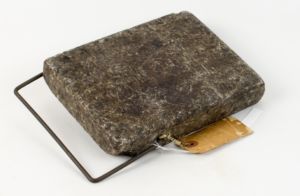
December 19, 2017
Though foreign to us today, warming stones like this one have been used for centuries, and they have been made from all kinds of stone. Soapstone, however, was preferred for its ability to heat up quickly, retain the heat, and radiate it for long periods of time. For this same reason, Native Americans used soapstone to carve vessels for cooking and keeping prepared food hot.
Warming stones like this one were truly efficient and multi-functional. This one incorporates a rotating iron rod for ease in handling and use. Warming stones were generally kept near a fire or a stove, ready to be heated up at a moment’s notice for warming the bed, warming one’s feet, or wrapped in furs or woolen blankets and placed in a carriage or sleigh.
Though soapstone is highly resistant to heat damage, this example bears the hallmark of many years of continuous use. It is worn smooth at the edges, and a large piece has broken from one corner.
This warming stone was donated to Hennepin History Museum by Carl A. Herrick, Professor of Mechanical Engineering at the University of Minnesota from 1925 to 1952.
About the author
Jack Kabrud is Hennepin History Museum’s curator.
